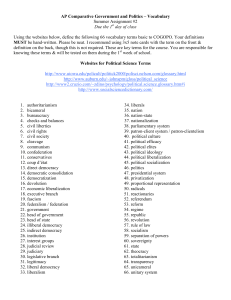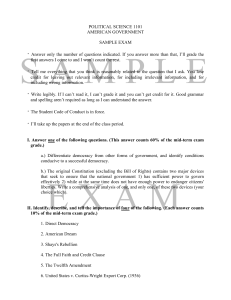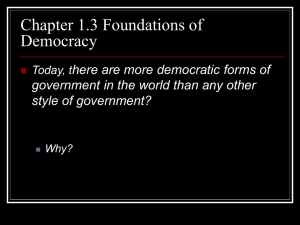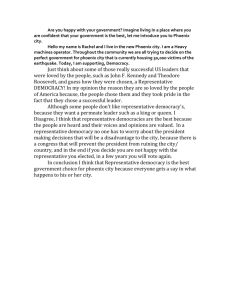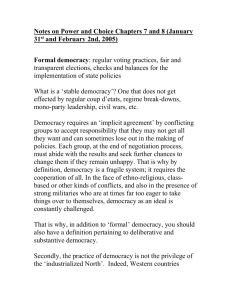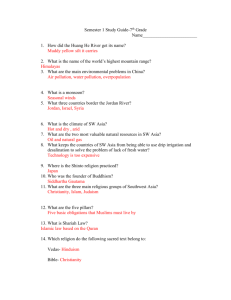Study Guide 5 - Los Medanos College
advertisement
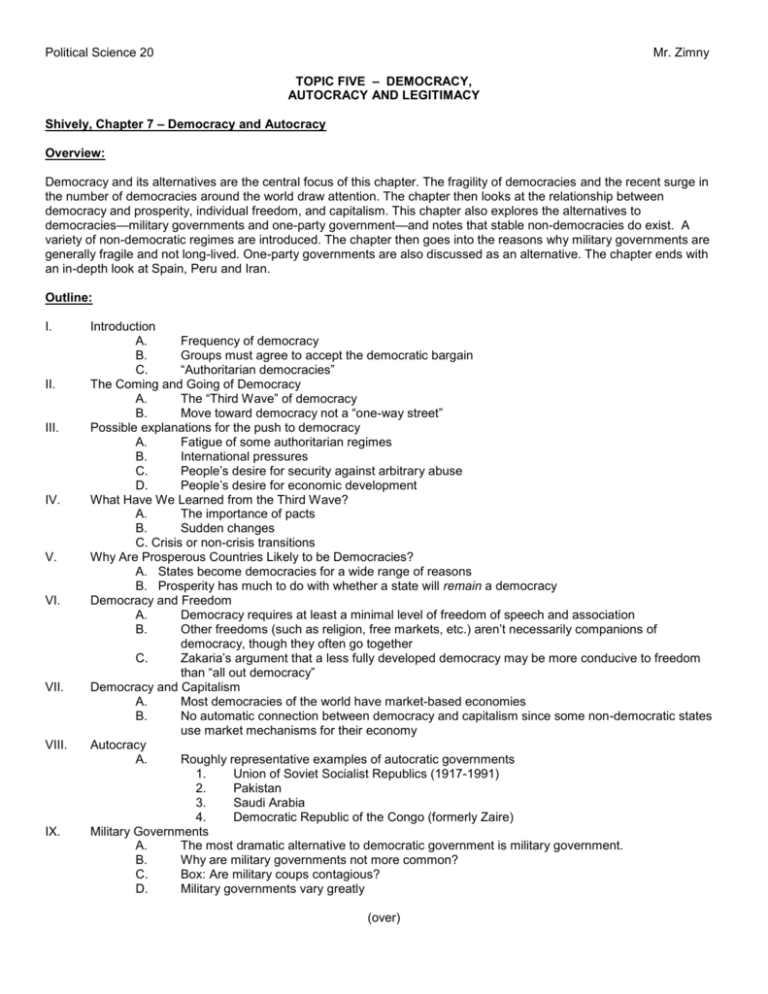
Political Science 20 Mr. Zimny TOPIC FIVE – DEMOCRACY, AUTOCRACY AND LEGITIMACY Shively, Chapter 7 – Democracy and Autocracy Overview: Democracy and its alternatives are the central focus of this chapter. The fragility of democracies and the recent surge in the number of democracies around the world draw attention. The chapter then looks at the relationship between democracy and prosperity, individual freedom, and capitalism. This chapter also explores the alternatives to democracies—military governments and one-party government—and notes that stable non-democracies do exist. A variety of non-democratic regimes are introduced. The chapter then goes into the reasons why military governments are generally fragile and not long-lived. One-party governments are also discussed as an alternative. The chapter ends with an in-depth look at Spain, Peru and Iran. Outline: I. II. III. IV. V. VI. VII. VIII. IX. Introduction A. Frequency of democracy B. Groups must agree to accept the democratic bargain C. “Authoritarian democracies” The Coming and Going of Democracy A. The “Third Wave” of democracy B. Move toward democracy not a “one-way street” Possible explanations for the push to democracy A. Fatigue of some authoritarian regimes B. International pressures C. People’s desire for security against arbitrary abuse D. People’s desire for economic development What Have We Learned from the Third Wave? A. The importance of pacts B. Sudden changes C. Crisis or non-crisis transitions Why Are Prosperous Countries Likely to be Democracies? A. States become democracies for a wide range of reasons B. Prosperity has much to do with whether a state will remain a democracy Democracy and Freedom A. Democracy requires at least a minimal level of freedom of speech and association B. Other freedoms (such as religion, free markets, etc.) aren’t necessarily companions of democracy, though they often go together C. Zakaria’s argument that a less fully developed democracy may be more conducive to freedom than “all out democracy” Democracy and Capitalism A. Most democracies of the world have market-based economies B. No automatic connection between democracy and capitalism since some non-democratic states use market mechanisms for their economy Autocracy A. Roughly representative examples of autocratic governments 1. Union of Soviet Socialist Republics (1917-1991) 2. Pakistan 3. Saudi Arabia 4. Democratic Republic of the Congo (formerly Zaire) Military Governments A. The most dramatic alternative to democratic government is military government. B. Why are military governments not more common? C. Box: Are military coups contagious? D. Military governments vary greatly (over) X. XI. XII. XIII. XII. Why aren’t there more military governments? A. Inhibitions against political intervention B. Lack of legitimacy C. Leaders may lack political skills D. Military governments often comprised of shaky alliances One Party States A. Distinguished from other types of autocratic systems by large national political party that bolsters government and provides institutional basis for it B. National party likely to embrace reasonable range of social groups C. Most common form of autocratic government D. More stable than purely military governments Monarchies and Theocracies Democracy vs. Autocracy: Material Considerations A. How democracies compare with autocracies in economic growth and overall quality of life Examples A. Democratization in Spain B. Fragile democracy in Peru C. Theocracy in Iran Keywords: democracy pacts crisis transitions regime autocracy military government coup authoritarian democracy one-party state monarchy theocracy Shively, Chapter 8 – How Individuals Relate to the State, and the State to the Individual Overview: This chapter examines the relationship between the state and its citizens through a discussion of authority, legitimacy, social capital, political culture and political socialization. The first part defines and highlights the sources of authority and legitimacy and examines how the state needs both to function effectively. Next, the chapter discusses the qualities of the ideal "democratic citizen" and examines how well the citizens of modern democracies measure up. The chapter then relates the concepts of social capital, culture, and religion as they relate to political culture and political socialization and their impact on the performance of democracies. Outline: I. II. III. IV. V. Authority A. Definition B. Governments and authority C. How authority is backed up through coercion, persuasion Legitimacy and authority Sources of legitimacy A. Legitimacy by results B. Legitimacy by habit C. Legitimacy by historical, religious or ethnic identity D. Legitimacy by procedures Qualities of a democratic citizen A. Tolerance B. Active participation C. High level of interest and information D. Varying support for the state Evaluation of these requirements (next page) VI. VII. VIII. IX. X. XI. Social capital A. Necessary ingredient for effective democratic government B. Robert Putnam’s studies of Italy and bowling league membership in the U.S. Political culture A. Varies greatly from state to state B. Responsible for major differences in how politics is conducted An Application of Political Culture: Robert Kagan's Of Power and Paradise. Religion and political culture A. increasing importance of religion in early 21st Century politics B. rise of political Islam C. comparison of values of people in the U.S. and Jordan Political socialization A. Agents of socialization 1. families 2. schools 3. peer groups Examples: A. Building authority and legitimacy in West Germany after WWII B. Declining democratic legitimacy in the U.S. Keywords: authority legitimacy social capital political culture political socialization agents of socialization


